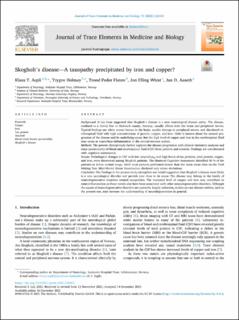| dc.description.abstract | Background
It has been suggested that Skogholt’s disease is a new neurological disease entity. The disease, confined to a family line in Hedmark county, Norway, usually affects both the brain and peripheral nerves. Typical findings are white matter lesions in the brain, myelin damage in peripheral nerves, and discolored cerebrospinal fluid with high concentrations of protein, copper, and iron. Little is known about the natural progression of the disease and its underlying cause, but the high level of copper and iron in the cerebrospinal fluid may cause or exacerbate inflammation in the central nervous system.
Methods
The present clinical study further explores the disease progression with clinical chemistry analyses and mass spectrometry of blood and cerebrospinal fluid (CSF) from patients and controls. Findings are corroborated with cognitive assessments.
Results
Pathological changes in CSF with low amyloid-β42 and high levels of tau proteins, total protein, copper, and iron, were discovered among Skogholt patients. The Montreal Cognitive Assessment identified 36 % of the patients as below normal range, while most patients performed slower than the norm mean time on the Trail Making Test. Mini-Mental Status Examination disclosed only minor deviations.
Conclusion
The findings in the present study strengthen our initial suggestion that Skogholt’s disease most likely is a new neurological disorder and provide new clues to its cause: The disease may belong to the family of neurodegenerative disorders termed tauopathies. The increased level of copper and iron may contribute to neuroinflammation as these metals also have been associated with other neurodegenerative disorders. Although the causes of neurodegenerative disorders are currently largely unknown, studies on rare disease entities, such as the present one, may increase the understanding of neurodegeneration in general. | en_US |

